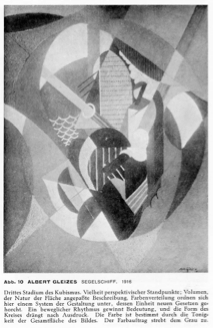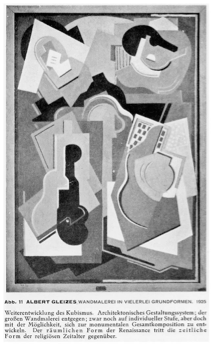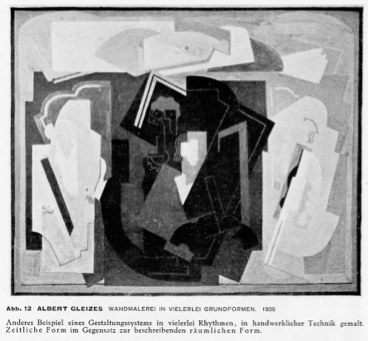Back to item index
Previous (Robert Delaunay)
Albert Gleizes
8. Albert Gleizes: Landscape, 1910
First phase of Cubism. The mechanism of volume. Perspective unity is not called into question. the descriptive anecdote is reduced to a schema. Colour is sacrificed to nuances of grey.
9. Albert Gleizes: Portrait of the Publisher, Figuière, 1913
Second phase of Cubism. The perspective of the Renaissance is under attack. Multiplicity of perspective points. Volume is repressed through the importance given to the surface. The descriptive element is divided up following an order which is intuitive and determined by the directions imposed by the limits of the picture. The timid little indications of colour are swallowed up in the larger unity which is given by the grey.

10. Albert Gleizes: Sailing Ship, 1916
Third phase of Cubism. Multiplicity of perspective points. The volume and the descriptive element are obliged to adapt themselves to the nature of the surface, and the distribution of the colours is arranged according to a plastic order which arrives at unity on the basis of new laws. A mobile rhythm gains in importance, and the form of the circle is seeking to be expressed. The colour is determined through the tonality which has been established over the whole surface of the picture. The way in which the colour has been applied is tending to move in the direction of grey.

11. Albert Gleizes: Mural painting with several elements, 1925
A further development of Cubism. A plastic order which is architectonic, which is heading in the direction of great, mural, painting - still, indeed, limited to the level of the particular, the individual, but containing in seed the possibility of developing into a total, monumental composition. Confrontation between the space-based form1 of the Renaissance, and the time-based form of the religious ages.

12. Albert Gleizes: Mural painting with several elements, 1926
Another example of a plastic order using several different rhythms, painted following a technique which is craftsmanlike rather than artistic. A form which is of the nature of time, as opposed to the form which is of the nature of space.